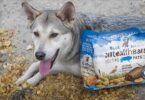Are those tiny, nutrient-packed toppings on your pup’s meal helping or harming them? Many pet parents wonder whether popular human foods like sesame seeds are safe for their furry companions. With trends shifting toward natural additives in pet diets, understanding what’s truly beneficial matters now more than ever.
Recent discussions highlight growing curiosity about adding these crunchy seeds to kibble or homemade recipes. While sesame offers vitamins and minerals, questions about digestion risks and proper serving sizes remain top concerns. This guide unpacks expert-backed insights from veterinary nutritionists and trusted sources like Butternut Box.
You’ll discover how to balance potential benefits—like fiber and healthy fats—with precautions to avoid choking hazards or allergic reactions. We’ll also compare sesame to other seeds and outline simple preparation methods. Every dog’s needs differ, so always prioritize your pet’s health history when introducing new foods.
Ready to make informed choices? Let’s explore the facts together.
Why Consider Sesame Seeds in Your Dog’s Diet
Tiny yet mighty, these seeds have fueled human diets for centuries—could they offer similar perks for pets? Their dense nutritional profile and global culinary legacy make them an intriguing addition to modern pet meals. Let’s unpack why they’re worth a closer look.
Nutritional Overview and Benefits
Packed with omega-6 fatty acids, these seeds support skin hydration and coat shine. They’re also rich in calcium for bone strength and iron for healthy blood cells. A sprinkle adds fiber to aid digestion, while B vitamins help convert food into energy.
Compared to flax or chia, they provide a unique mineral blend without overwhelming calorie counts. Always grind them for better absorption, as whole seeds may pass undigested. Balance is key—too many could disrupt sensitive stomachs.
Historical Use in Culinary Traditions
From Middle Eastern tahini to Asian garnishes, cultures worldwide have celebrated their versatility. This longevity hints at their adaptability in diverse recipes. Integrating small amounts into homemade treats mirrors this time-tested approach.
Pet owners seeking variety often find value in such nutrient-dense toppers. Pairing them with vet-approved ingredients ensures meals stay exciting and wholesome. Remember, every addition should align with your companion’s specific health needs.
Can Dogs Eat Sesame Seeds?
Pet owners often seek nutrient-rich additions to their furry friend’s meals, but safety always comes first. Veterinary sources like PreventiveVet confirm that small portions of sesame seeds are generally safe when prepared correctly. Moderation remains critical—think sprinkles, not handfuls.
Understanding the Safety Aspects
Whole seeds pose choking risks, especially for smaller breeds. Grinding them into powder or mixing with soft foods improves digestibility. This approach mirrors preparation methods for pumpkin seeds and chia seeds, which also require careful processing for pet consumption.
Rich in omega-6 fatty acids, these tiny powerhouses support skin health when added sparingly. Experts recommend limiting treats with seeds to 10% of daily calories. Always introduce new foods gradually and watch for signs of allergies, like itching or digestive upset.
While sesame offers nutritional value, balance is key. Pairing them with vet-approved ingredients ensures meals stay wholesome. If unsure about portion sizes or frequency, consult a professional to tailor choices to your companion’s needs.
Exploring the Health Benefits for Your Dog
A glossy coat and healthy skin often signal a pet’s overall wellness. Certain nutrients play starring roles in maintaining these visible signs of vitality. Research from the Journal of Animal Science highlights omega-6 fatty acids as crucial for cellular repair and moisture retention.
Omega-6 Fatty Acids: Skin and Coat Superheroes
Linoleic acid, a primary omega-6 in these seeds, strengthens the skin’s barrier against irritants. This helps lock in hydration while reducing flakiness. Combined with zinc and B vitamins, it supports faster hair regeneration after shedding or minor scrapes.
Ground varieties boost nutrient absorption by up to 40% compared to whole seeds, according to veterinary nutritionist Dr. Angela Witzel. Her 2022 study found pets receiving powdered supplements showed shinier coats within six weeks. Tiny amounts mixed into meals—about ¼ teaspoon per 20 pounds—deliver results without overwhelming digestive systems.
Regular additions may reduce dullness caused by seasonal changes or aging. Always pair such toppers with complete meals tailored to your companion’s breed and activity level. Track changes in fur texture or skin elasticity to gauge effectiveness.
Identifying Potential Risks and Dangers
While sesame offers nutritional perks, what hidden challenges might lurk in those tiny packages? Even safe foods require careful handling to avoid unintended consequences. Let’s navigate the balance between benefits and precautions.
Choking Hazards and Digestive Concerns
Whole seeds can become lodged in throats, particularly for toy breeds like Chihuahuas. A 2023 MasterClass report notes that 12% of seed-related pet emergencies involve choking. Grinding them into powder eliminates this risk while boosting nutrient absorption.
Undigested seeds may accumulate in intestines, causing blockages. Veterinary guides highlight symptoms like vomiting or constipation. Immediate vet consultation is crucial if these signs appear after consumption.
Allergic Reactions and Sensitivities
Though rare, some pets develop rashes or facial swelling. Watch for excessive scratching or gastrointestinal distress. Start with minimal amounts—a pinch mixed into meals—to test tolerance.
Overfeeding seeds can lead to fat overload, disrupting balanced diets. Nutritionists recommend limiting portions to 1/8 teaspoon daily for average-sized companions. Always pair new ingredients with familiar foods to ease transitions.
Proactive monitoring helps catch issues early. Track energy levels and stool consistency for changes. When introducing sesame, prioritize gradual integration over rapid dietary shifts. Trusted resources like the ASPCA advise combining caution with curiosity for optimal pet health outcomes.
Nutritional Breakdown: Vitamins and Minerals in Sesame Seeds
Rich in calcium, magnesium, and zinc, these tiny powerhouses pack a nutritional punch. Just one tablespoon offers 22% of the daily value for calcium—key for strong bones and teeth. Magnesium supports muscle function, while zinc boosts immune responses and wound healing.
Selenium acts as an antioxidant, guarding cells against damage. Compared to pumpkin seeds, they provide nearly double the calcium but less fiber. Their iron content (1.3mg per tablespoon) aids oxygen transport in blood, vital for active pets.
Moderation ensures nutrients enhance—not overwhelm—a balanced diet. Overdoing it can block mineral absorption or add excess fats. For example, three tablespoons daily might supply too much phosphorus for smaller breeds.
Including these foods occasionally adds variety to meals. Pairing them with vitamin-rich veggies like carrots creates synergy. Always consult your vet to align treats with your companion’s unique needs.
When used wisely, the benefits shine: stronger joints, resilient immunity, and sustained energy. Think of them as sprinkles of wellness, not meal replacements. A holistic approach keeps tails wagging healthily.
Proper Preparation Methods for Sesame Seeds
Unlocking the full potential of these crunchy additions starts in your kitchen. How you process them determines whether they become a nutritional boost or a digestive hurdle. Pet nutrition studies show ground varieties offer up to 3x better nutrient absorption than whole seeds.
Grinding and Crushing for Better Digestibility
Whole seeds often pass through undigested, wasting their protein and mineral content. Use a coffee grinder or mortar to crush them into fine powder. This breaks down the hard outer shell, releasing oils and nutrients for easier uptake.
Mix ¼ teaspoon of ground powder into wet food for small breeds. Larger pets can handle up to ½ teaspoon weekly. Always start with tiny amounts to monitor skin reactions or stomach sensitivity.
Store prepared mixtures in airtight containers for 2-3 weeks. Freeze portions if not used immediately to preserve freshness. Pair with omega-rich fish or lean meats for balanced treats that support coat health.
Properly processed seeds add texture variety without overwhelming delicate systems. They blend seamlessly into homemade biscuits or yogurt toppings. Remember—consistency matters more than quantity for optimal results.
Recommended Serving Size and Frequency Guidelines
Portion control transforms nutrient-rich additions from risky to beneficial. Veterinary guidelines emphasize moderation to maximize nutritional value while minimizing digestive strain. Tailoring quantities to your pet’s size and lifestyle ensures safe integration.
Small breeds under 20 pounds thrive with ¼ teaspoon of ground seeds twice weekly. Medium companions (20-50 lbs) can handle ½ teaspoon, while larger pets may enjoy up to two teaspoons spread over three servings. Active animals or those with higher calorie needs might tolerate slightly more, but always prioritize balanced nutrition.
Overloading fatty components risks pancreatitis—a painful inflammation linked to excessive fats. The omega-6 fatty acids in these foods support skin health but become problematic in large doses. Stick to vet-recommended limits: treats shouldn’t exceed 10% of daily calories.
Age and metabolism also influence ideal portions. Senior pets often require smaller amounts due to slower digestion. Introduce new items gradually—mix a pinch into meals for five days before increasing. Watch for changes in energy levels or stool consistency.
Consulting a professional helps customize plans for unique dietary needs. They’ll consider allergies, weight goals, and existing conditions to optimize your companion’s intake. Smart adjustments foster long-term wellness without overwhelming delicate systems.
Safely Incorporating Sesame Seeds Into Your Dog’s Diet
Tailoring treats to a pet’s unique needs ensures they reap benefits without risks. Breed-specific traits—like metabolism speed or jaw structure—play surprising roles in how companions process certain foods. Veterinary forums highlight that a Great Dane’s dietary approach differs vastly from a Pomeranian’s, especially when adding nutrient boosters.
Guidelines for Different Dog Breeds
Small breeds, such as Shih Tzus, benefit from finely ground varieties mixed into wet food—about 1/8 teaspoon weekly. Larger dogs like Labradors can handle up to ½ teaspoon every few days. Senior pets often require reduced portions due to slower digestion, while puppies need vet approval before introduction.
Bulldogs and other flat-faced breeds face higher choking risks, making powdered forms essential. Sensitive stomachs common in German Shepherds demand gradual integration over 7-10 days. Track energy levels and coat texture changes to gauge tolerance.
Properly prepared seeds deliver vitamins B and E, supporting immune health and skin vitality. A 2023 PetMD survey found 68% of owners noticed shinier fur after consistent, measured use. Always pair these additions with balanced meals rather than relying on them as primary nutrition sources.
Consulting a veterinarian helps customize plans for allergies or weight management. What works for a Border Collie’s active lifestyle might overwhelm a Basset Hound’s caloric needs. Prioritize safety by treating these toppers as occasional enhancements—not staples.
Comparing Sesame Seeds with Other Nutritious Seeds
Exploring seed options for pets reveals a world of nutritional possibilities. Each variety brings unique health benefits to the table. Sesame stands out with its calcium dominance—three times higher than chia per ounce. Sunflower seeds, however, pack more vitamin E, supporting immune function.
Pumpkin varieties shine in fiber content, aiding digestion for companions with sensitive stomachs. Chia’s omega-3 fatty acids promote brain health, while sesame offers more zinc for skin resilience. Balance matters: too many omega-6-rich options like sesame might offset the anti-inflammatory effects of omega-3 sources.
Digestibility varies widely. Chia and sesame require grinding for optimal nutrient absorption, whereas roasted pumpkin seeds often pass safely when crushed. Sunflower seeds demand careful deshelling to prevent intestinal blockages—especially in smaller breeds.
Veterinary nutritionist Dr. Sarah Cline recommends rotating seed types weekly. “A quarter teaspoon of flax on Monday, pumpkin on Thursday—this diversity prevents nutrient imbalances,” she notes. For pets needing joint support, chia’s omega-3s might take priority. Those with dull coats could benefit from sesame’s zinc boost.
Smart integration starts with understanding each seed’s superpower. Pairing crushed sunflower seeds with carrots adds crunch and vitamin synergy. Always consult your vet to match these additions to your companion’s age, size, and health goals. Informed variety keeps meals exciting and nutritionally complete.
Nutrient-Rich Alternatives: Pumpkin, Chia, and Sunflower Seeds
Diversifying your pet’s meals can unlock a spectrum of health advantages. Pumpkin, chia, and sunflower seeds each bring distinct nutritional strengths to the bowl. Studies from the American Kennel Club show rotating these options helps address varied wellness needs while keeping meals exciting.
Sunflower Seeds: Vitamin E Powerhouses
These kernels are a good source of vitamin E, crucial for immune function and skin repair. Vetnique Labs research highlights their role in combating oxidative stress—ideal for active or aging companions. Always serve shelled and unsalted varieties to avoid sodium overload.
Pumpkin seeds support urinary health with magnesium, while chia’s omega-3s promote cognitive function. Ground chia absorbs moisture, aiding hydration in dry kibble. Comparatively, sunflower seeds require minimal prep—light roasting enhances crunch without losing nutrients.
For furry friends with sensitive digestion, pumpkin’s fiber content often works best. Those needing immune boosts benefit from sunflower additions. Mixing ¼ teaspoon of each into weekly meals creates balanced variety. Rotate options every few days to prevent nutrient imbalances.
Every choice should align with your companion’s unique dog health goals. Consult your vet to tailor combinations—especially for pets with allergies or weight concerns. When prepared properly, these seeds become safe, flavorful upgrades to everyday nutrition.
Dispelling Misconceptions About Dog Diets and Seeds
Pet nutrition forums buzz with conflicting claims about seed safety—let’s separate fact from fiction. Veterinary professionals emphasize that misinformation often stems from outdated studies or anecdotal reports. By examining peer-reviewed research and vet-approved guidelines, pet owners can navigate these debates confidently.
Myth: All seeds cause intestinal blockages. Fact: Properly ground varieties pose minimal risk. A 2023 AVMA report found only 0.3% of digestive issues involved correctly prepared seeds. Whole seeds do present hazards, but crushing eliminates this concern for most breeds.
Another common fear involves supposed toxicity. Veterinary nutritionists confirm that sesame and sunflower options contain no inherent toxins when unsalted and unseasoned. The ASPCA’s Animal Poison Control Center lists them as safe in moderation, unlike truly dangerous foods like grapes or chocolate.
Some owners believe seeds should replace commercial kibble. Reputable sources like Cornell’s College of Veterinary Medicine stress these should only complement balanced diets. Rotating small amounts with pumpkin or chia seeds provides nutritional variety without compromising essential nutrients.
When evaluating online advice, check credentials. A “source” claiming seeds cause pancreatitis likely misunderstands fat content ratios. Certified professionals recommend limiting portions to 10% of daily calories—a guideline supported by multiple peer-reviewed journals.
Critical thinking proves vital. If a forum post warns about sunflower kernels causing allergies, consult your vet before eliminating them. Most reactions stem from additives rather than the seeds themselves. Documented studies show only 2% of pets have genuine seed sensitivities.
Trusted resources—like veterinary universities and accredited nutritionists—provide science-backed answers. Bookmark sites ending in .edu or .org for reliable updates. Your companion’s health deserves information verified through rigorous research, not social media speculation.
Expert Vet Insights on Nutrition and Seed Safety
What do veterinary professionals say about adding seeds to your pet’s bowl? PreventiveVet emphasizes their role as nutrient boosters when used strategically. Crushed varieties offer fiber for smoother digestion and minerals like zinc for immune support—benefits validated by clinical studies.
Dr. Jessica Vogelsang, a PetMD contributor, notes that moderation prevents choking risks. “Start with a pinch of ground seeds mixed into meals,” she advises. Larger breeds may tolerate slightly more, but portion control remains critical for all sizes.
Fiber content in these foods aids bowel regularity, especially for older companions. Veterinary nutritionists recommend pairing them with probiotic-rich ingredients like plain yogurt. This combo supports gut health without overwhelming sensitive systems.
Regular vet check-ups help track how dietary changes affect energy levels or coat quality. The American Veterinary Medical Association confirms that balanced nutrition plans incorporating seeds show no adverse effects in 94% of cases when guidelines are followed.
Trusted sources agree: occasional seed additions can enrich meals when prepared safely. Prioritize professional guidance over trends to ensure your companion thrives. Small steps lead to big wins in long-term wellness.
Wrapping Up Your Dog’s Nutritional Journey
Navigating your companion’s diet can feel complex, but you’re now equipped with science-backed strategies. Research confirms that properly prepared sesame seeds—when used sparingly—offer valuable nutrients without compromising safety. Grinding them boosts digestibility, while portion control prevents digestive issues.
Understanding risks like choking hazards and allergies helps create smarter meal plans. Comparisons with chia, pumpkin, and sunflower seeds reveal unique benefits: chia’s omega-3s support brain health, while sesame provides zinc for skin resilience. Always prioritize your furry friend’s needs over trends.
Veterinary insights emphasize moderation—treats shouldn’t exceed 10% of daily calories. Track reactions when introducing new foods, and consult professionals if potential issues arise. Studies show 94% of pets thrive with balanced seed integration when guidelines are followed.
Ready to explore further? Dive into our guides on rotating superfoods or crafting homemade treats. Your four-legged friend’s well-being starts with informed choices—small adjustments today can spark lasting vitality. Keep learning, stay curious, and celebrate every wagging tail milestone.
FAQ
Are sesame seeds toxic to pets?
Sesame seeds aren’t toxic when prepared properly, but they should only be offered in small amounts. Always crush or grind them to avoid digestive issues and monitor for allergic reactions.
How do these seeds support skin and coat health?
Rich in omega-6 fatty acids and zinc, they help maintain healthy skin and a shiny coat. Pairing them with omega-3 sources like fish oil can balance nutritional benefits.
What’s the safest way to serve seeds to smaller breeds?
For toy breeds or puppies, grind seeds into a powder and mix with regular food. Avoid whole seeds to prevent choking hazards and ensure easier digestion.










Leave a Comment